
The Yeti, also known as the Abominable Snowman or the Meteh Kangmi is a large humanoid creature throught to dwell in the Himalayan Mountians. Mainstream scientce considers the Yeti as nothing more than a haox or misidentification of an already known speicies, but thost who have seen the Yeti have a much different belief. The Western name Yeti is derived from the Tibetan word Yeh-Teh, which translates into “little man-like animal”. It is a false cognate with Old English geottan, or yettin in modern English, which is an antiquated word for an orc or troll. In the Sherpa language, the word Yeti actualy means “That there thing”.
In 1921 the name Abominable Snowman was coined by British Lieutenant Colonel Charles Kenneth Howard-Bury. While leading “The Everest Reconnaisance” group on the Lhakpa La in the Mount Everest region, Howard-Bury’s team discovered strange footprints at about 20,000 feet up. When Howard-Bury returned to Calcutta he discribed his sighting to Henry Newman, a reporter for The Statesman. While documenting the story, Newman mistranslated the word Metoh from the full name Meteh Kangmi, the words the Sherpas had used to describe the creature, Meteh meaning dirty, fifthy or discusting and Kangmi meaning man of the snow. Instead of translating the name Meteh as he should he translated the word Metoh which was mistranslated into abominable. 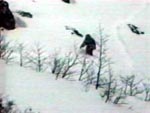 So what about the 'abominable snowman' is so abominable? Perhaps it's the idea of something so close to us intellectually yet so different physically. Maybe it's the brute force suggested by relatively scarce tales. Quite possibly, it might be the idea that we, humanity, have areas to conquer that are ruled by beasts such as this. The idea of an animal of this form certainly makes us uneasy. Or maybe it's the chilling environment within which it resides: The Himalayas are as famous for their sheer size as they are for this beast that lurks amidst their peaks. The mountain chain has a length of about 2,400 kilometers and a width about 200 to 400 kilometers. Numerous peaks protrude into the sky at over 7,600 meters, one of them being the famed Mount Everest. These measurements are constantly being rendered obsolete as the mountains continue to rise every year as India impels into Nepal. When one considers the remoteness and size of this region of the earth, it does seem conceivable for a large creature, such as the reputed 'abominable snowman' to roam about the valleys, woods, crevices, and peaks of this behemoth mountain chain and elude humanity.
So what about the 'abominable snowman' is so abominable? Perhaps it's the idea of something so close to us intellectually yet so different physically. Maybe it's the brute force suggested by relatively scarce tales. Quite possibly, it might be the idea that we, humanity, have areas to conquer that are ruled by beasts such as this. The idea of an animal of this form certainly makes us uneasy. Or maybe it's the chilling environment within which it resides: The Himalayas are as famous for their sheer size as they are for this beast that lurks amidst their peaks. The mountain chain has a length of about 2,400 kilometers and a width about 200 to 400 kilometers. Numerous peaks protrude into the sky at over 7,600 meters, one of them being the famed Mount Everest. These measurements are constantly being rendered obsolete as the mountains continue to rise every year as India impels into Nepal. When one considers the remoteness and size of this region of the earth, it does seem conceivable for a large creature, such as the reputed 'abominable snowman' to roam about the valleys, woods, crevices, and peaks of this behemoth mountain chain and elude humanity.
The Yeti has become a tourist attraction, although not to the extent of its North American cousin, Sasquatch. A person can sleep in the Yak & Yeti hotel or luxuriate in a warm meal at the Yeti bar, and get there by flying Yeti Airlines. But above 1,336 meters, commercialism ends and the bare truth takes over: frigid wind, immeasurable snow, absolute isolation, and the possibility of a wild, hairy hominid watching you from around some frozen bend. The Yeti seems to avoid people more than people attempt to avoid it. Perhaps that is why it is so experienced at parrying mankind.
For thousands of years, the legend of the Yeti remained confined to its remote area, where it is worshiped, inscribed in scrolls, and represented in the annual Mani Rimdu Festival. The Yeti is vaguely mentioned in the older days, perhaps first by Alexander the Great when his unrestrained sights fell on the Indus Valley. He would have liked to be presented with one, but the native people told him that the creature was unable to breathe properly at lower altitudes. In 79 A.D., Pliny the Elder wrote in his Natural History about creatures, living "in the Land of the Satyrs", that are swift and able to run on two and four feet. They had "human-like bodies, and because of their swiftness can only be caught when they are ill or old." After various other small odds and ends of information, Aelianus in his Animal Stories wrote: 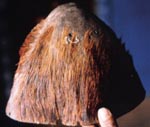 "If one enters the mountains neighboring India one comes upon lush, overgrown valleys. The Indians call this region Koruda. Animals that look like the Satyrs roam these valleys. They are covered with shaggy hair and have a long horse's tail When left to themselves they stay in the forest and eat tree sprouts. But when they hear the din of approaching hunters and the barking of dogs, they run with incredible speed to hide in the mountain caves. For they are masters at mountain climbing. They also repel approaching humans by hurling stones down at them."
"If one enters the mountains neighboring India one comes upon lush, overgrown valleys. The Indians call this region Koruda. Animals that look like the Satyrs roam these valleys. They are covered with shaggy hair and have a long horse's tail When left to themselves they stay in the forest and eat tree sprouts. But when they hear the din of approaching hunters and the barking of dogs, they run with incredible speed to hide in the mountain caves. For they are masters at mountain climbing. They also repel approaching humans by hurling stones down at them."
The first time this creature was publicized in the Western world was some period within the 1800s by British military and Indian Civil Service. B.H. Hodgson had been in Nepal from 1820 to 1843, working at the Nepalese court. The British resident mentioned that his porters had, much to their fright, encountered a hairy, tail-less Wildman in northern Nepal. It was in the year of 1889 that more of the story spread to the west. At the time, unaccompanied western explorers seeking the culture and beauty of the Himalayas had to cloak themselves as wayfarers or nomadic tradesmen. It is in that very year that footprints were first reported in Major L. A. Waddell's book, Among the Himalayas.
Northeast of Sikkim, he had stumbled upon a trail of large footprints in the snow at 5,000 meters. His porters informed him of the Yeti and their belief that it left the footprints in the snow. Waddell dismissed this wild claim, and it was his belief that they were merely tracks of the red snow bear that resides in the region, Ursus isabellinus.  Soon, however, Tibet started to allow outsiders into this secluded region, and numerous expeditions set out to conquer Everest. And as they did so, the Yeti became a worldwide sensation with more evidence surfacing. The first attempts to climb the northward face of Everest, by Lt.-Col. C. K. Howard-Bury also succeeded in sighting mysterious black figures in the distance. When he and his companions reached the spot on September 22, 1921, conveniently located at 7000 meters, they found enormous footprints, those of the alleged Metoh Kangmi.
Soon, however, Tibet started to allow outsiders into this secluded region, and numerous expeditions set out to conquer Everest. And as they did so, the Yeti became a worldwide sensation with more evidence surfacing. The first attempts to climb the northward face of Everest, by Lt.-Col. C. K. Howard-Bury also succeeded in sighting mysterious black figures in the distance. When he and his companions reached the spot on September 22, 1921, conveniently located at 7000 meters, they found enormous footprints, those of the alleged Metoh Kangmi.
In 1925, N.A. Tombazi, a photographer and member of the Royal Geographical Society, saw a creature at about 15,000 ft near Zemu Glacier. Tombazi witnessed this humanoid figure, wandering about in an upright fashion while leading an expidition to the South Glaciers of Kangchenjunga in the Sikkim Himalaya. He witnessed the strange creature pause to tug on dwarf rhododendron bushes as it passed, its dark figure casting extreme contrast to the white snow. Wearing no clothing the creature was easilty distinguishable, any more observations of the beast where cut short as the creature moved into some thick brush and disappeared. Tombazi would later write:  "...a couple of hours later, during the descent, I purposely made a detour so as to pass the place where the 'man' or 'beast' had been seen. I examined the footprints, which were clearly visible on the surface of the snow. They were similar in shape to those of a man, but only six to seven inches (15 to 17 cm) long by four inches (23 cm) wide at the broadest part of the foot. The marks of five distinct toes and the instep were perfectly clear, but the trace of the heel was indistinct, and the little that could be seen of it appeared to narrow down to a point. I counted fifteen such footprints at regular intervals ranging from one-and-a-half to two feet (30 to 45 cm). The prints were undoubtedly of a biped, the order of the spoor having no characteristics whatever of any imaginable quadruped. Dense rhododendron scrub prevented any further investigations as to the direction of the footprints..."
"...a couple of hours later, during the descent, I purposely made a detour so as to pass the place where the 'man' or 'beast' had been seen. I examined the footprints, which were clearly visible on the surface of the snow. They were similar in shape to those of a man, but only six to seven inches (15 to 17 cm) long by four inches (23 cm) wide at the broadest part of the foot. The marks of five distinct toes and the instep were perfectly clear, but the trace of the heel was indistinct, and the little that could be seen of it appeared to narrow down to a point. I counted fifteen such footprints at regular intervals ranging from one-and-a-half to two feet (30 to 45 cm). The prints were undoubtedly of a biped, the order of the spoor having no characteristics whatever of any imaginable quadruped. Dense rhododendron scrub prevented any further investigations as to the direction of the footprints..."
30 years later, the famed Eric Shipton had his first encounter with the creature's trails. Accompanying him were Michael Ward and Sen Tensing. The tracks they found were located within the Gauri Sankar range, not far from Everest itself, a location Shipton had previously attempted to climb five times.
The tracks stretched for about 1600 meters, dodging about and between crevasses, and eventually ending in a moraine. The tracks set about in this pattern measured thirty centimeters long. To display this oddity, Shipton laid down his pickaxe adjacent to one of the prints and snapped one of the most famous photographs representing this animal. From the picture, and Shipton's description, one can discern the big toe easily, for it is separated from the other three. One cannot be sure whether there are three or four other toes, two toes held together closely can seemingly merge into one when imprinted on the snow. Assuming that this is indeed some form of ape, five toes seems more plausible. 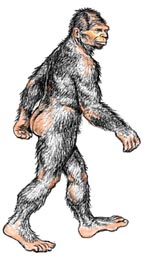 As mentioned, Shipton and his companions followed the tracks to their end in the moraine. But could it be that they were led into the wrong direction by assuming that the directions that the toes pointed is forward? That sentence might have sounded peculiar at first, but one must take into account many reports of the animal's bizarre manner of walking and gait with tendency to walk with its toes facing backward and heel facing forward. Curiously, many reports mention this detail. This method of walking can also be found in the Orang pendek, another hominoid like creature reputed to roam the jungles of Sumatra. There, however, the backward-step description is much more prominent. Within Megasthene's Inica, one can find the line, "In the mountains called Nulo there are men whose feet point backwards and have eight toes on the ends."
As mentioned, Shipton and his companions followed the tracks to their end in the moraine. But could it be that they were led into the wrong direction by assuming that the directions that the toes pointed is forward? That sentence might have sounded peculiar at first, but one must take into account many reports of the animal's bizarre manner of walking and gait with tendency to walk with its toes facing backward and heel facing forward. Curiously, many reports mention this detail. This method of walking can also be found in the Orang pendek, another hominoid like creature reputed to roam the jungles of Sumatra. There, however, the backward-step description is much more prominent. Within Megasthene's Inica, one can find the line, "In the mountains called Nulo there are men whose feet point backwards and have eight toes on the ends."
The 'eight toes' is something mentioned scarcely by Sherpas, and can easily be ruled out. No tracks with such deformities have been found, nor have any reports included this feature. Bears, although they don't have eight toes, do have a tendency to turn their toes inward and heels outward. Also, the bear's small toe is actually the largest, and thus can be mistaken. When one looks down at their own foot, they would notice that the line of the foot slopes from the big toe down to the small toe. This is not consistent with the footprints photographed by Eric Shipton, however. There the line slopes downward from the small toes to the big toe, thus implying that the big toe is actually the small toe. It might be helpful to recite the preceding tongue twister several times so it can be fully understood. Needless to say, Shipton's photographs have proven very controversial.
The following account was published in the November 2, 1921 edition of The Times. It follows the account of Englishman William Knight, this being four years prior to Tombazi's encounter. He was returning from Tibet, in the Gangtok area, when he saw a beast much like a man, who was "…a little under 6 ft, 1.8 meters, high, almost stark naked in that bitter cold, it was the month of November. He was a kind of pale yellow all over, about the color of a Chinaman, a shock of matted hair on his head, little hair on his face, highly splayed feet, and large, formidable hands. His muscular development in the arms, thighs, legs and chest was terrific. He had in his hand what seemed to be some form of primitive bow." 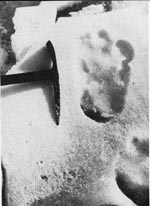 This is not the only encounter hinting at the possibility of tool usage and relatively eminent mentality. Jean Marques-Riviere told of his encounter in L'Inde Secrete et sa Magie. There, he tells how he joined a band of Nepalese men who informed him of footprints found and an armed expedition was to go in search of there creator. He joined the group and they trekked the "jungle 3 meters high". Then, several days after their initial start, a continual, repetitive rumbling sound broke the silence. As the group drew nearer to the source of the echoing sound, the prints of "snowmen" fell besides their own, and the group scattered. Finally, only three men were willing to move onward, one of them being Marques-Riviere.
This is not the only encounter hinting at the possibility of tool usage and relatively eminent mentality. Jean Marques-Riviere told of his encounter in L'Inde Secrete et sa Magie. There, he tells how he joined a band of Nepalese men who informed him of footprints found and an armed expedition was to go in search of there creator. He joined the group and they trekked the "jungle 3 meters high". Then, several days after their initial start, a continual, repetitive rumbling sound broke the silence. As the group drew nearer to the source of the echoing sound, the prints of "snowmen" fell besides their own, and the group scattered. Finally, only three men were willing to move onward, one of them being Marques-Riviere.
"We went forward cautiously; the noise grew louder. Suddenly, one of us made a sign to stop and look. In front of us, in a natural circle of high rocks, among the huge hunks of broken stone, an extraordinary spectacle met our eye; some ten giant ape-men, 3 to 4 meters high, were gathered in a ring. One of them was beating a primitive tom-tom made of a hollow tree-trunk. The man's strength must have been terrific to judge by the noise he was making. The others swayed silently in time with the tom-tom. It was some religious ceremony, no doubt, for their solemn manner and attitude showed that they were performing a magic rite. Their bodies were covered with hair and their faces were halfway between a gorilla's and a man's. But there was nothing of the animal about their attitude, and the one that was beating the tom-tom stood upright like a human being. They were quite naked, in spite of the bitter cold in this desolate region and a strange sadness could be seen on their frightful faces." 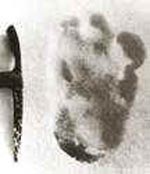 The tale does not stop there, but proceeds into the author questioning the creature’s existence. Readers can draw one conclusion about these tales: although often romanticized, these stories do have some root in reality. But how precisely can this reality be defined?
The tale does not stop there, but proceeds into the author questioning the creature’s existence. Readers can draw one conclusion about these tales: although often romanticized, these stories do have some root in reality. But how precisely can this reality be defined?
Yellow skin below matted hair, extremely robust body, cone-shaped head, and an oddly human stance, this is the common description of the Yeti. As with most crypto zoological beings, people have attempted to link it with a presumed extinct prehistoric animal, and have succeeded in doing so. The similarities between the Yeti and what is known as Gigantopithecus blacki is almost uncanny. This giant ape, with proportions that coincide with those of the Yeti, was discovered by Ralph Von Koenigswald in the unlikeliest of places: a jar full of teeth in a Chinese medicine shop. Later, a jawbone of this beast was found in a Chinese cave, one of the same caves that are reputed to hold another hairy hominid, the Yeren. When compared with the jaw of a gorilla, the true proportions of this monstrous creature are clearly shown.
As with all extinct creatures, we can only speculate to its true appearance. 3 and 4 meters high, standing on its hind legs, the creature must have been a terror to all animals scurrying about in the Middle Pleistocene period. But, do we really have to speculate, or can we perhaps simply look for the Yeti?
Gigantopithecus was not the only giant ape to have seemingly disappeared thousands of years ago. Pithecanthropus erectus, officially announced in 1894, was at first, considered the 'Missing Link.' Ralph Von Koenigswald, who originally discovered the teeth of Gigantopithecus, organized a three-year expedition to excavate more ape-men in 1936. Shortly after the expedition began the team discovered a new ape creature. It bore much similarity to the Pithecanthropus, yet was given its own genus, Sinanthropus. This discovery happened in Peking, this could mean it is possible that ape men such as this were spread throughout Asia at the time, and may still be thriving in isolated groups. These are smaller than the average Yeti, yet could account for one of the three groups of Yetis, as will later be discussed.  After his finds of Pithecanthropus, Ralph Von Koenigswald proceeded onward to find yet another ape, this time considerably larger. It was christened Meganthropus palaeojavanicus. The jawbone, the only remains of this beast, seemed more human than those of the Gigantopithecus, and about a quarter smaller, but still titanic in comparison to the modern apes and Homo sapiens. Meganthropus' proportions were similar to those of Gigantopithecus, with an estimated height of 3 meters.
After his finds of Pithecanthropus, Ralph Von Koenigswald proceeded onward to find yet another ape, this time considerably larger. It was christened Meganthropus palaeojavanicus. The jawbone, the only remains of this beast, seemed more human than those of the Gigantopithecus, and about a quarter smaller, but still titanic in comparison to the modern apes and Homo sapiens. Meganthropus' proportions were similar to those of Gigantopithecus, with an estimated height of 3 meters.
Then again, who said that the Yeti had to be some form of extinct creature at all? Consistent with some suspicious footprints, it is entirely plausible that the Yeti is a common black bear. Reinhold Messner holds that belief after researching the topic first hand, as documented in his book, My Quest for the Yeti. According to him, the idea of the Yeti to the locals is that of a 'man bear.' Messner himself sighted a yeti on two separate occasions, the second of which he was pursued in the darkness and sought refuge in a local village. But after witnessing a bear in the act of running on two legs, he became convinced that the Yeti phenomenon could be fully accounted for by taking in the possibility of the snowman being a mere Ursus. This idea should not be disappointing, if it is indeed true. A new species of bear would also be quite provoking, although perhaps not as stirring as a giant ape further up on the evolutionary ladder.
As more and more cases are examined, the Yeti does start to hold uncanny resemblance to simple bears. Big, hairy, hulking, and with an omnivorous diet it does point in a definite and possible direction, though one that slips through the general public's fingers because of its lack of romance. In a letter to Messner, the German explorer and zoologist Erns Schäfer wrote that in 1934 he had gone in search of the Himalayan beast, hoping to bring back a male and female exemplar, and in Inner Tibet he managed to shoot "a number of Yetis, in the form of the mighty Tibetan bear, Ursus thibetanus." He claimed that Shipton and Smythe had asked him not to publish his findings so that they would still receive funding for their next Everest expedition. Could it be that Tombazi, Messner, Knight, Waddell, and all others have been describing a bear? 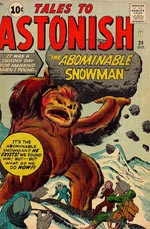 There are a number of bears that reside in this region. The Asiatic or Tibetan black bear has a wide range that reaches from Iran to Russia to Japan and is known to live in the Himalayas. These animals have long, black fur, particularly around the shoulders and throat. They have large ears and a white patch across their chests. These omnivorous mammals live up to 25 years and males have been known to reach up to 200 kilograms in weight. The interesting part is that they are known to be aggressive toward man and tend to stand on their back legs when frightened or aggravated. And because of their amazing ability to stand on their hind legs, they are often trained to dance as cubs for amusement. This is perhaps the likeliest candidate for the Yeti should it actually be a bear..
There are a number of bears that reside in this region. The Asiatic or Tibetan black bear has a wide range that reaches from Iran to Russia to Japan and is known to live in the Himalayas. These animals have long, black fur, particularly around the shoulders and throat. They have large ears and a white patch across their chests. These omnivorous mammals live up to 25 years and males have been known to reach up to 200 kilograms in weight. The interesting part is that they are known to be aggressive toward man and tend to stand on their back legs when frightened or aggravated. And because of their amazing ability to stand on their hind legs, they are often trained to dance as cubs for amusement. This is perhaps the likeliest candidate for the Yeti should it actually be a bear..
Among the snow leopards and yaks, and behind the black bear there is also the brown bear, having many similar characteristics in its size and longevity. Of all the bears on earth, this particular species has the widest range and can be found in Europe, Asia, and America. In the countries surrounding Nepal, they are listed as endangered. Still, could such a widespread species be held accountable for all the sightings, furs, and prints left in the snow? If not, then there is always the Tibetan blue bear, one of the rarest specimens from the Ursus genus. And lastly, there is the Himalayan red bear, Ursus isabellinus, After examining these animals, it is clear that there are quite a bit of big, hairy, and hulking things in the Himalayas besides the reputed Yeti, ones that could turn out to be the famed 'Abominable Snowman.'
Messner's encounters do have quite a bit of resemblance to other sightings and the fact that he became convinced that it was simply a bear shows that it may very well be that way. At the sight of one bear running away on two legs, Messner said that it "looked uncannily like a wild man." The only factor to counter this is that the lamas and Sherpas know the region well and yet they are the ones convinced that the Yeti is more than a simple mashiung, or bear. For them, the black bears are a totally separate animal. One would think that the local and nomadic people occupying the region would be familiar with the local fauna. But there will always be sceptics. The sighting Messner later attributed to a bear goes as follows:
"Making my way through some ash-colored juniper bushes, I suddenly heard an eerie sound¾a whistling noise, similar to the warning call mountain goats make. Out of the corner of my eye I saw the outline of an upright figure dart between the trees to the edge of the clearing, where low-growing thickets covered the steep slope. The figure hurried on, silent and hunched forward, disappearing behind a tree only to reappear again against the moonlight. It stopped for a moment and turned to look at me. Again I heard the whistle, more of an angry hiss, and for a heartbeat I saw eyes and teeth. The creature towered menacingly, its face a grey shadow, its body a black outline. Covered with hair, it stood upright on two short legs and had powerful arms that hung down almost to its knees. I guessed it to be over seven feet tall. Its body looked much heavier than that of a man of that size, but it moved with such agility and power toward the edge of the escarpment that I was both startled and relieved. Mostly I was stunned. No human would have been able to run like that in the middle of the night. It stopped again beyond the trees by the low-growing thickets, as if to catch its breath, and stood motionless in the moonlit night without looking back."
The famous Austrian mountain climber knew the Himalayas well and had trekked across the region over fifty separate times since 1970. His questions to the Sherpas yielded many different answers, but none supported the Yeti being something with the likeness of a hominid. All the stories of the Yeti have become garbled and indefinite with truth diluted in a gigantic mass of rumors and fictional tales put together for tourists. In the mind of the natives, the Yeti is no definite thing that is there. It is beyond material, a more spiritual being. People in Tibet hold an indefinite line between that which is true and that which is spiritual. Still, sacrifices are still made in Nepal to the mystical beast before men leave villages for the hunt. In Tibet, however, Buddhism does not permit for such killings.
One of the things that perplex researchers about these creatures and the footprints they leave in their wake is the altitude at which they are found. Upwards of 6000 meters, it is rare to see anything but a bird. There are animals that live above this line, but they lead an active lifestyle where they descend into the woods below daily in search of food. It is possible that the Yeti is some form of ape that we already are familiar with, yet has adapted to its frigid environment. As Dr. Bernard Heuvelmans mentions in his book, On the Track of Unknown Animals, it is possible for an ape, such as on orang-utan for instance, to resort to walking on its hind legs so it has less area touching the icy snow beneath. Orang-utans are even known to have once lived in the foothills of the Himalayas.
It is also possible that, just as some of its animal neighbors, the Yeti lives at the higher altitudes, only to descend into the woods below for food. One can imagine that this is quite exhausting, especially in the harsh conditions of the Himalayas, but apparently, creatures do manage to sustain a lifestyle in this manner. According to Charles Stonor and the other men confined within his group, this creature fed upon the small, mouse-like creatures, marmots and pikas that thrive amidst the rocks. This statement was based on a combination of information from the natives and actual animal droppings, the latter of which two discoveries were made. Oddly, mixed in with the animal fur and bones was earth, present for unknown reasons. Some natives added juvenile yaks, tahr, musk deer, and birds and their eggs to the menu.
Another possibility is that the Yeti, when sighted at these altitudes is simply passing across the snowy peaks to get from one valley to another. In the woods below, one could walk within several meters of this beast and not know it, save for the smell. But in the vast, white, and open expanses of the snowy peaks and tilted plains above, the dark-haired creature is hard to miss. This theory may explain why most sightings occur there as well.
Yet it is possible that none of these ordinary and other long gone beasts can account for the sightings of the 'yeh-teh'. Sightings and folklore divide the Yeti phenomenon into three distinct groups.
The mih-teh, meaning 'a man-like living thing that is not a human being.', is the most commonly mentioned Yeti. When one refers to the giant ape creature with the sloping forehead and the enormous feet, they are speaking about the mi-teh, or the meh-teh. This is considered dangerous, especially in comparison with the two other types. The creature's description can be compiled into that of a stocky ape-man with an eerie human quality to it. Short, coarse reddish-brown to black in color hair runs down especially at the shoulders. Amidst the hair is the robust face with large teeth and mouth. A conical head, certainly a notable feature, is also described.
The second type of Yeti is the dzu-teh, 'a hulking thing.' The creature is not dangerous in any way to man, and it is the largest of the Yetis. It is reputed to lead an omnivorous diet and to walk on four and two legs, leading many people to believe that it is no more than the common black bear, as discussed above.
And lastly, there is the teh-lma, a third type of Yeti discerned from folklore and tales by Gerald Russell. This Yeti is quite different from the other two, being a little less than a meter high at its peak age, about 45 centimeters at earlier stages. It is nocturnal, and it cannot be ruled out that the mih-teh and the dzu-teh are nocturnal as well. While the other Yetis are seen at dizzying heights, this creature is said to thrive within the forests below, stalking frogs among other creatures under the shroud of night. Being much smaller than the other Yetis does not alter the creature's amazing strength, for this beast too is reputed to hold immense vigor.
As with most expeditions that set out to search for crypto zoological creatures, be it in the African Congo or in the Himalayas, the search for the Yeti has turned up little evidence to hold up the heavy weight supported by its believers. The most excitement in a typical expedition comes from a track of footprints across the snow. Although exhilarating to consider what kind of creature made them, they are not anything new and unprecedented in science, with hundreds of different cases documenting these inexplicable impressions in the snow.
It is not quite clear who first set foot upon the peak of Everest, Sir Edmund Hillary or Tensing Norgay. It is clear, however, that on the way there and back, Hillary gathered tales about the mysterious creature, the Yeti, and found him immersed in it later on. This would also lead to the examination of the controversial and elusive yeti scalp.
Perhaps the most interesting, and questionable as mentioned above, evidence for the Yeti came in 1953. On October 9th, Rusy Gandhy, J. A. Gaitonde, P. V. Pattankar, and Navnit Parekh stopped at the Pangboche monastery. There, the four mountaineers were informed of the presence of a sacred object, the scalp of the mountain man within the walls of the local gompa. Reluctantly, they were shown the scalp, along with Professor Christoph Von Furer-Haimendorf, who conveniently happened to be a passing anthropologist, and Dr. Charles Evans.
Indeed, the scalp does fit the description of the Yeti, with a conical shape and long hairs running down the side, while the top is bald. One can assume that this is not a trait of age in the being itself, but rather, the fact of a long dead creature, from which the scalp was detached.
The problem lay at the scalp's purpose, an object of sacred worship. In its absence, bad luck would be bestowed upon the monastery and its inhabitants. No bad luck came from reducing the scalp's hair to one less, and the single hair was sent of to Dr. Leon A. Hausman in New Jersey.
On an expedition funded by the Daily Mail, the discovery of a second scalp in Khumjung had everyone involved hopefully to prove the creature’s existence. When examined, the two scalps both bore similar characteristics, and as experts would note, they were made of a single piece of skin. Sadly, the same can't be said for a third scalp in Namche Bazar. Either the scalp had not properly been removed from the beast atop which it once resided, or more likely, it was no more than an imitation. Could jealousy lead natives to fake a sacred object? Perhaps it was indeed fabricated long ago and over the course of time people forgot its falsified origin and genuinely began to believe in its authenticity. Whatever the case may be this indeed raised doubt in the other objects' genuineness.
Another expedition to seek the Yeti set out in 1957. Tom Slick, with a successful career in the oil industry and a taste for the mysterious, pushed forth the expedition for the next three years, over the course of the expedition many hairs where sent in for examination. And accompanying the tale of the scalp with which they returned is the bones of what is reputed to be a Yeti. They were discovered by Peter Byrne within the Pangboche monastery. The bones seem rather small, especially in contrast with the scalp. They, too, are very controversial, partially due to the manner in which they were obtained. Mr. Byrne, for the sake of science and curiosity, ended up having to lead one of the monastery caretakers to drunkenness just so he could switch the bones of the Yeti with those of a man. Rather than proving anything with this act, Byrne only complicated the situation. Primates do have comparatively small hands, but the bones are no bigger than those of a human. They affirm nothing, and could very well be human.
Then, a Japanese expedition went looking for the Yeti. Leading it was Dr. Teizo Ogawa of Tokyo University. It comes as no surprise that, after examining the scalps, more hairs were taken. From all of these hair samples, the creature's identity could not be revealed, but one thing was true: all three scalps, even the one made of patches, had the same hairs interpolated into their skin. So, they had come from the same animal, whether a bulky, hominid ape, or some harmless forest-dwelling creature.
At the time of examination, technology was not at the level it is today; thus analysis could not be taken further. However, with new technologies and developments, startling new evidence has come about. For the moment, however, scientist could only put it beneath the objective of a microscope and compare it with hairs from other known animals. Although the scientist did not find a scapegoat to point to, they did eliminate all possible animals within the Himalayas, as well as a wide range of other mammals from the far corners of the globe. Dr. Hausman's skepticism leads him to believe that the skin was brought from some travelers or tourists, being some animal from some other country, and was left there.
Also, because of the arrangement and direction of the hairs, it is not possible to have come from another animal's back, the most likely origin of the skin if Dr. Hausman is correct. The largest portion of unvarying skin can be found on an animal's hind. All of this speculation and mystery led Sir Edmund Hillary to go in attempt to persuade the natives to lend the scalp temporarily while it is examined in detail. After much debating, the locals gave in and the scalp was sent off to Chicago, where it would be forwarded to Paris, and lastly to London. After extensive examination, the scalp was labeled as the 200-year-old skin of the serow, a goat-like creature that is indeed present in the Himalayas. Yeti or not, when returned, the scalp was yet again placed as the monastery's sacred object.
So the scalp, not proven authentic or fake, still rests confined within the walls of the monastery, gathering dust and loosing valuable hairs that could be equated to one of the greatest discoveries of our time. But the series of rumored anatomical remains of Yetis was not limited to hands and scalps. In other monasteries, furs and even an entire 400-year-old mummified corpse have been found. Thorough examination of all of them has not turned up any startling evidence. The mummy's hands were supported by sticks rather than bones. But do these invalid specimens imply that the entire Yeti myth is false?
At the turn of the century, a new startling discovery was made. A British expedition set out in search of this elusive creature when mysterious hairs were found in the hollow of a cedar tree in the eastern Bhutan area. Naturally, the hairs were carefully removed in a forensic manner and flown back to Britain.
"We found some DNA in it, but we don't know what it is. It's not a human, not a bear nor anything else we have so far been able to identify. It's a mystery and I never thought this would end in a mystery. We have never encountered DNA that we couldn't recognize before."
This is the analysis set forth by Bryan Spykes, a Professor of Human Genetics at the Oxford Institute of Molecular Medicine.
And so it remains to this day, shrouded in a riddle with insufficient material. With all this supporting evidence, and amounting physical evidence, it seems that we have not really excelled much farther than from the times that the Western world first heard of this enchanting tale. If there is indeed a bulky, hairy bipedal hominid roaming the remote valleys and woods of Nepal and Tibet, it is possible that it will elude science for many years to come. Or perhaps, its discovery is right around the corner. Then again, the entire Yeti phenomenon may be nothing more than our imaginations running wild. Odd things can happen at high altitudes where air is icy and thin. But if discovered, the mountain men will simply be added to the tree of life and to wildlife databases, and then forgotten like the mountain gorillas and the Komodo dragons that inspired tales just as riveting as the Yeti.
The Evidence
Unlike most Cryptid creatures the Yeti actually has a wealth of physical evidence, but does this evidence support the Yeti’s existence or disprove it as an already known species. Like its American counterpart, Yeti footprints are the most common form of evidence that suggests something large and unknown has recently walked through the snow. Perhaps the strangest bit of evidence as brought back to London hidden in the suitcase of actor Jimmy Stewart in 1959.
Although it has never been determined exactly what creature the hand once belonged to, a picture of the famed hand is now on display at Disney Land in promotion of their new ride, Expedition Everest. There are also scalps which reportedly belong to the Yeti, used as sacred artifacts in local monasteries these scalps are rarely available for testing. However a hair sample was obtained and when tested did not match any know creature. On top of all of this physical evidence, credible sightings of the creature have been reported since modern man first began to explore the region.
The Sightings
In 1832, the Journal of the Asiatic society of Bengal published the account of B. H. Hodgson, who wrote that while trekking in northern Nepal, his native guides spotted a tall, bipedal creature covered with long dark hair, then fled in fear. Hodgson did not see the creature, but concluded it was an orangutan.
An early record of reported footprints appeared in 1889 in L.A. Waddell's Among the Himalayas He reported his native guides described a large apelike creature that left the prints, but concluded the prints were made by a bear. Waddell heard stories of bipedal, apelike creatures, but wrote that of the many witnesses he questioned, none "could ever give me an authentic case. On the most superficial investigation it always resolved into something that somebody had heard of."
The frequency of reports increased in the early 20th century, when Westerners began making determined attempts to climb the many mountains in the area and sometimes reported seeing odd creatures or strange tracks.
In 1925, N.A. Tombazi, a photographer and member of the Royal Geographical Society, saw a creature at about 15,000 ft near Zemu Glacier. Tombazi later wrote that he observed the creature from about 200 or 300 yards, for about one minute.
"Unquestionably, the figure in outline was exactly like a human being, walking upright and stopping occasionally to pull at some dwarf rhododendron bushes. It showed up dark against the snow, and as far as I could make out, wore no clothes." About two hours later, Tombazi and his companions descended the mountain, and saw what they took to be the creature's prints, described as "similar in shape to those of a man, but only six to seven inches long by four inches wide.... The prints were undoubtedly those of a biped."
In the 1950s, Slawomir Rawicz in a book ghostwritten by British reporter Ronald Dowling claimed that he had seen two large, apelike creatures while crossing the Himalaya in 1942. He claimed to have observed the creatures for several hours from a distance of about 100 m (109 yards). However, Rawicz's claim is now considered to be a hoax and it has been proven that he was never in the Himalayas in 1942.
Western interest in the yeti peaked dramatically in the 1950s. While attempting to scale Mount Everest in 1951, Eric Shipton took photographs of a number of large prints in the snow, at about 6,000 m (19,685 ft) above sea level. These photos have been subject to intense study and debate. Some argue they are the best evidence of Yeti's reality, but others contend the prints are from a mundane creature and have been distorted and enlarged by the melting snow.
In 1953, Sir Edmund Hillary and Tenzing Norgay reported seeing large footprints while scaling Mount Everest. Hillary would later discount yeti reports as unreliable.
During the Daily Mail Abominable Snowman Expedition of 1954, the largest search of its kind, the mountaineering leader John Angelo Jackson, made the first trek from Everest to Kangchenjunga and in the process photographed symbolic paintings of the yeti at Thyangboche Gompa. Jackson tracked and also photographed many footprints in the snow, many of which were identifiable. However, there were many large footprints which could not be identified. The flattened footprint like indentations were attributed to erosion and subsequent widening of the original footprint by wind and particle action.
Beginning in 1957, Tom Slick, an American who had made a fortune in oil, funded a few missions to investigate yeti reports. In 1959, feces reportedly from a yeti were collected by Slick's expedition. Analysis found a parasite but could not classify it. Bernard Heuvelmans wrote that "Since each animal has its own parasites, this indicated that the host animal is equally an unknown animal."
In 1959, actor Jimmy Stewart, while visiting India, reportedly smuggled the remains of a supposed yeti, the so-called Pangboche Hand, by hiding them in his luggage when he flew from India to London.
In 1960, Sir Edmund Hillary mounted an expedition to collect and evaluate evidence for the yeti and sent a yeti scalp from the Khumjung monastery to the West for testing. The results indicated that the scalp had been manufactured from the skin of the serow, a goat-like Himalayan antelope. But some disagreed with this analysis. Shackley said they "pointed out that hairs from the scalp look distinctly monkey-like, and that it contains parasitic mites of a species different from that recovered from the serow."
In 1970, British mountaineer Don Whillans says he saw a creature while scaling Annapurna. While scouting for a campsite, Whillans heard some odd cries. His sherpa guide told him the sound was a yeti's call. That night, reported Whillans, he saw a dark shape moving near his camp. The next day, Whillans observed a few human like footprints in the snow, and that evening, he asserted that with binoculars, he watched a bipedal, ape-like creature for about 20 minutes as it apparently searched for food not far from his camp.
The Stats – (Where applicable)
• Classification: Hominid
• Size: Most reports at about 9ft tall however smaller versions are reported too
• Weight: Unknown
• Diet: Varies from Mean to Local Plant Life
• Location: Himalayan Mountains
• Movement: Walking
• Environment: Snow Covered Mountains and Forest Rich Valleys
|